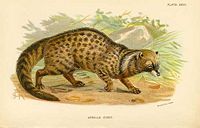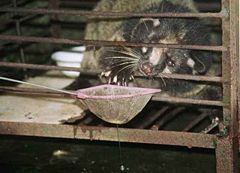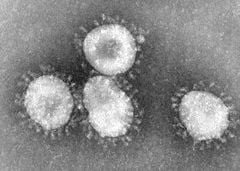Difference between revisions of "Civet" - New World Encyclopedia
Rick Swarts (talk | contribs) |
Rick Swarts (talk | contribs) |
||
| Line 25: | Line 25: | ||
'''Civets''' are small, lithe-bodied, mostly arboreal [[mammal]]s native to the tropics of Africa and Asia. '''Civet''' may also refer to the distinctive [[musk]] produced by the animal. | '''Civets''' are small, lithe-bodied, mostly arboreal [[mammal]]s native to the tropics of Africa and Asia. '''Civet''' may also refer to the distinctive [[musk]] produced by the animal. | ||
| + | |||
| + | |||
| + | '''Nandiniidae'''. Family [[Nandiniidae]] ([[African palm civet]]) has only one species ''(Nandinia binotata)'', extant across [[sub-Saharan Africa]]. They have retractile claws and are slender-bodied, arboreal omnivores (with fruit making up much of their diet). They are relatively small with the larger males weighing up to five kilograms (11 pounds). | ||
| + | |||
| + | '''Viverridae'''. Family [[Viverridae]] (the [[binturong]], [[civet]]s, [[genet (animal)|genet]]s, [[Asiatic linsang|Asiatic]] and [[African Linsang|African linsang]]) has 30 extant species and all have retractile claws. They are extant in Southern Europe, Africa, and Asia. They range in size from 500 grams (one pound) up to medium-sized carnivores at 14 kilograms (39 pounds). They have long bodies and short legs and usually have long tails (some prehensile). Diet ranges from small mammals and insects through to [[crustacean]]s and [[mollusk]]s. | ||
| + | |||
| + | :'''Eupleridae'''. Family [[Eupleridae]], the "Malagasy carnivores," includes [[Fossa (animal)|fossa]], [[falanouc]], [[Malagasy civet]], and [[Galidiinae|Malagasy mongoose]]s, all of which are restricted to the island of [[Madagascar]]. There are eight species in the family. Variations in form among the eight species are significant, however. These differences initially led to the species in this family sharing common names with, and being placed in the different families of, seemingly more similar species on the mainland (e.g. civets and mongoose). However phylogenetic analysis of [[DNA]] provides strong evidence that all [[Malagasy]] carnivores evolved from a single common ancestor that was a herpestid (Yoder et al. 2003; Yoder and Flynn 2003). Recent phylogenetic analysis supports this view and places all of the Malagasy carnivores in the family Eupleridae (Gaubert et al. 2005). | ||
| + | |||
| + | ==Overview and description== | ||
| + | All extant feliforms share a common attribute: the characteristics of their auditory bullae, the bony capsules enclosing the [[middle ear|middle]] and [[inner ear]]. This is a key diagnostic in classifying species as Feliform versus Caniform. In feliforms, the auditory bullae are double-chambered, composed of two bones joined by a [[septum]]. Caniforms have single-chambered or partially divided auditory bullae, composed of a single bone. The specific characteristics of extant feliform bullae suggest a common ancestor, though one has not been identified in the [[fossil]] records. | ||
| + | |||
==Taxonomy== | ==Taxonomy== | ||
| Line 59: | Line 70: | ||
==References== | ==References== | ||
{{reflist}} | {{reflist}} | ||
| + | * Gaubert, P., W. C. Wozencraft, P. Cordeiro-Estrela, and G. Veron. 2005. [http://www.ncbi.nlm.nih.gov/pubmed/16282167 Mosaics of convergences and noise in morphological phylogenies: What's in a viverrid-like carnivoran?] ''Syst Biol.'' 54(6):865-94. | ||
| + | |||
| + | * Myers, P., R. Espinosa, C. S. Parr, T. Jones, G. S. Hammond, and T. A. Dewey. 2008. [http://animaldiversity.ummz.umich.edu/site/accounts/classification/Feliformia.html#Feliformia Suborder Feliformia (feliform carnivores)] ''Animal Diversity Web''. Retrieved September 6, 2008. | ||
| + | |||
| + | * Yoder, A. D., and J. J. Flynn. 2003. [http://www.biology.duke.edu/yoderlab/pdfs/ipYoderFlynnNHMad.pdf Origin of Malagasy carnivora] Pages 1253-1256 in S. M. Goodman and J. Benstead, eds., ''The Natural History of Madagascar''. University of Chicago Press. ISBN 0226303063. | ||
| + | * Yoder, A. D., M. Burns, S. Zehr, T. Delefosse, G. Veron, S. Goodman, J. Flynn. 2003. [http://www.biology.duke.edu/yoderlab/pdfs/2003YoderBurnsNature.pdf Single origin of Malagasy Carnivora from an African ancestor] ''Nature'' 42:734-737. Retrieved September 6, 2008. | ||
[[Category:Life sciences]] | [[Category:Life sciences]] | ||
Revision as of 23:16, 26 December 2008
| Civets | ||||||||||
|---|---|---|---|---|---|---|---|---|---|---|
 African Civet, Civettictis civetta
| ||||||||||
| Scientific classification | ||||||||||
| ||||||||||
|
Civets are small, lithe-bodied, mostly arboreal mammals native to the tropics of Africa and Asia. Civet may also refer to the distinctive musk produced by the animal.
Nandiniidae. Family Nandiniidae (African palm civet) has only one species (Nandinia binotata), extant across sub-Saharan Africa. They have retractile claws and are slender-bodied, arboreal omnivores (with fruit making up much of their diet). They are relatively small with the larger males weighing up to five kilograms (11 pounds).
Viverridae. Family Viverridae (the binturong, civets, genets, Asiatic and African linsang) has 30 extant species and all have retractile claws. They are extant in Southern Europe, Africa, and Asia. They range in size from 500 grams (one pound) up to medium-sized carnivores at 14 kilograms (39 pounds). They have long bodies and short legs and usually have long tails (some prehensile). Diet ranges from small mammals and insects through to crustaceans and mollusks.
- Eupleridae. Family Eupleridae, the "Malagasy carnivores," includes fossa, falanouc, Malagasy civet, and Malagasy mongooses, all of which are restricted to the island of Madagascar. There are eight species in the family. Variations in form among the eight species are significant, however. These differences initially led to the species in this family sharing common names with, and being placed in the different families of, seemingly more similar species on the mainland (e.g. civets and mongoose). However phylogenetic analysis of DNA provides strong evidence that all Malagasy carnivores evolved from a single common ancestor that was a herpestid (Yoder et al. 2003; Yoder and Flynn 2003). Recent phylogenetic analysis supports this view and places all of the Malagasy carnivores in the family Eupleridae (Gaubert et al. 2005).
Overview and description
All extant feliforms share a common attribute: the characteristics of their auditory bullae, the bony capsules enclosing the middle and inner ear. This is a key diagnostic in classifying species as Feliform versus Caniform. In feliforms, the auditory bullae are double-chambered, composed of two bones joined by a septum. Caniforms have single-chambered or partially divided auditory bullae, composed of a single bone. The specific characteristics of extant feliform bullae suggest a common ancestor, though one has not been identified in the fossil records.
Taxonomy
The common name is used for a variety of carnivorous mammalian species, mostly of the family Viverridae (although it resembles the other civets, the African Palm Civet (Nandinia binotata) is genetically distinct and belongs in its own monotypic family, Nandiniidae).
In 2005, the World Wide Fund for Nature released photos taken by a night time camera trap of an unknown carnivore (nicknamed the cat-fox) on Borneo. Scientists debate whether this animal is new species of civet, or a known, but rare, species (such as Hose's Palm Civet, thought previously to be extinct).
Physical characteristics
Civets have a broadly cat-like general appearance, though the muzzle is extended and often pointed, rather like an otter or a mongoose. They range in length from about 17 to 28 in. (40 to 70 cm) (excluding their long tails) and in weight from about 3 to 10 lb (1 to 5 kg).
Habitat
Viverrids are native to Africa (except the area immediately south of the Mediterranean), Madagascar, the Iberian Peninsula, southern China, and Southeast Asia. Favoured habitats include woodland, savanna, and mountain biomes and, above all, tropical rainforest. In consequence, many are faced with severe loss of habitat; several species are considered vulnerable and the Otter Civet is classified as endangered.
Sri Lanka
In Sri Lanka, the asian palm civet species is known as "Uguduwa" by the Sinhala speaking community. The term Uguduwa and Kalawedda is used interchangeably by the Sri Lankan community to refer to the same animal.[1] However, the term Kalawedda is mostly used to refer to a different species of the civet family, which is similar in appearance to the Ring-tailed Cat.
Exotic Dung Coffee
Kopi Luwak, also known as caphe cut chon (fox-dung coffee) in Vietnam and kape alamid in the Philippines, is coffee that is prepared using coffee cherries that have been eaten and partially digested by the Asian Palm Civet, then harvested from its feces.
Behavior
Very little is known about civets' mating habits. They breed year round, producing litters of 1-6 fully-furred babies after a gestation period of 60-81 days. Some species may have 2 litters per year. Civets are omnivorous, supplementing a meat diet (both hunted and scavenged) with fruit, eggs, and possibly roots.
Musk
The civet produces a musk (also called civet) highly valued as a fragrance and stabilizing agent for perfume. Both male and female civets produce the strong-smelling secretion, which is produced by the civet's perineal glands. It is harvested by either killing the animal and removing the glands, or by scraping the secretions from the glands of a live animal. The latter is the preferred method today.

Animal rights groups, such as the World Society for the Protection of Animals, express concern that harvesting musk is cruel to animals. Between these ethical concerns and the availability of synthetic substitutes, the practice of raising civets for musk is dying out. Chanel, maker of the popular perfume Chanel No. 5, claims that natural civet has been replaced with a synthetic substitute since 1998.[citation needed]
SARS
Virologists have speculated[attribution needed] that the source of the SARS-CoV virus, which had a significant outbreak in Asia in 2003, can be traced back to a particular species of civet, the Masked Palm Civet.[citation needed] Many people hunt the Masked Palm Civet for its meat; many virologists[attribution needed] believe that through these practices the SARS virus was first introduced to humans. However, the possibility remains that the virus may have been contracted in some other unknown animal before infecting the Masked Palm Civet. Since this information has been exposed to the public, the ingestion of civets in Asia has dropped drastically, going from 51% of people that do not eat civets to 72%.[2]
ReferencesISBN links support NWE through referral fees
- ↑ [1]
- ↑ Press, Associated. "Civets, Other Wildlife Off the Chinese Menu." MSNBC. 18 Apr. 2008. 6 July 2008 <http://www.msnbc.msn.com/id/12371160/>.
- Gaubert, P., W. C. Wozencraft, P. Cordeiro-Estrela, and G. Veron. 2005. Mosaics of convergences and noise in morphological phylogenies: What's in a viverrid-like carnivoran? Syst Biol. 54(6):865-94.
- Myers, P., R. Espinosa, C. S. Parr, T. Jones, G. S. Hammond, and T. A. Dewey. 2008. Suborder Feliformia (feliform carnivores) Animal Diversity Web. Retrieved September 6, 2008.
- Yoder, A. D., and J. J. Flynn. 2003. Origin of Malagasy carnivora Pages 1253-1256 in S. M. Goodman and J. Benstead, eds., The Natural History of Madagascar. University of Chicago Press. ISBN 0226303063.
- Yoder, A. D., M. Burns, S. Zehr, T. Delefosse, G. Veron, S. Goodman, J. Flynn. 2003. Single origin of Malagasy Carnivora from an African ancestor Nature 42:734-737. Retrieved September 6, 2008.
Credits
New World Encyclopedia writers and editors rewrote and completed the Wikipedia article in accordance with New World Encyclopedia standards. This article abides by terms of the Creative Commons CC-by-sa 3.0 License (CC-by-sa), which may be used and disseminated with proper attribution. Credit is due under the terms of this license that can reference both the New World Encyclopedia contributors and the selfless volunteer contributors of the Wikimedia Foundation. To cite this article click here for a list of acceptable citing formats.The history of earlier contributions by wikipedians is accessible to researchers here:
The history of this article since it was imported to New World Encyclopedia:
Note: Some restrictions may apply to use of individual images which are separately licensed.
